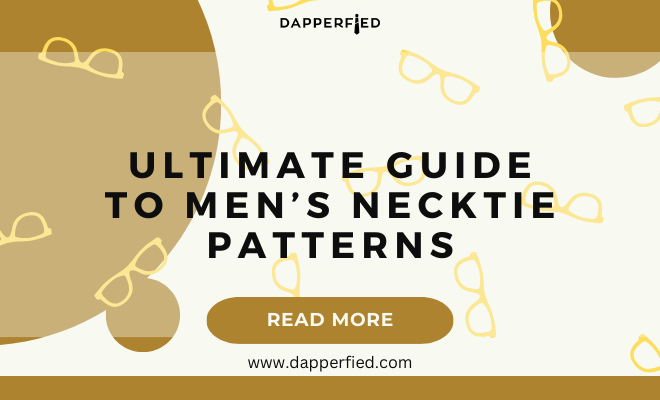
Men's Style
Ultimate Guide to Men’s Necktie Patterns
When it comes to necktie patterns, there is a wide variety to choose from, each with its own unique style and appeal. Understanding the different types of necktie patterns can help you make informed decisions when selecting the perfect tie for any occasion. Some of the most common necktie patterns include stripes, dots, solid colors, geometric designs, floral patterns, abstract designs, paisley, houndstooth, and plaid. Each pattern has its own distinct characteristics and can be paired with different shirts and suits to create a polished and stylish look.
In addition to the aesthetic appeal, the choice of necktie pattern can also convey a certain message or mood. For example, classic patterns like stripes and dots are often associated with professionalism and formality, making them ideal for business settings or formal events. On the other hand, bold and modern patterns like geometric designs and abstract prints can add a touch of personality and flair to an outfit, making them perfect for more casual or creative environments. Traditional patterns like paisley, houndstooth, and plaid have a timeless and sophisticated appeal, making them versatile options for a variety of occasions. By understanding the basics of different necktie patterns, you can make informed choices that reflect your personal style and the message you want to convey.
Key Takeaways
- Necktie patterns come in various types, including classic, bold, modern, and traditional designs.
- Classic patterns like stripes, dots, and solid colors are timeless and versatile options for neckties.
- Bold and modern patterns such as geometric, floral, and abstract designs can add a contemporary touch to your outfit.
- Traditional patterns like paisley, houndstooth, and plaid are great for adding a vintage or heritage feel to your look.
- When pairing necktie patterns with shirts and suits, consider the color and scale of the patterns to create a cohesive and stylish ensemble.
Classic Patterns: Stripes, Dots, and Solid Colors
Classic necktie patterns like stripes, dots, and solid colors are timeless and versatile options that can be paired with a wide range of shirts and suits. Striped ties are a popular choice for professional settings, as they exude a sense of formality and sophistication. Whether it’s a traditional regimental stripe or a more modern pinstripe design, striped ties can add a touch of elegance to any outfit. Dotted ties, on the other hand, offer a more playful and whimsical vibe, making them a great choice for less formal occasions or creative environments. The subtle yet stylish appeal of dotted ties makes them a popular choice for adding a pop of personality to an outfit.
Solid color ties are perhaps the most versatile option, as they can be paired with almost any shirt or suit. Whether it’s a classic black tie for formal events or a bold red tie for a pop of color, solid color ties are a wardrobe staple that every man should have in his collection. When it comes to classic necktie patterns, it’s important to consider the scale and color of the pattern in relation to the shirt and suit you’ll be wearing. By understanding how to pair classic patterns with different outfits, you can create a polished and put-together look for any occasion.
Bold and Modern Patterns: Geometric, Floral, and Abstract Designs
For those looking to make a statement with their necktie, bold and modern patterns like geometric designs, floral prints, and abstract patterns are the way to go. Geometric ties feature bold shapes and lines that can add a contemporary and stylish touch to any outfit. Whether it’s a classic herringbone pattern or a more intricate maze design, geometric ties are a great way to showcase your individuality and creativity. Floral ties offer a more romantic and whimsical vibe, making them a popular choice for weddings or other special occasions. The delicate yet eye-catching appeal of floral prints can add a touch of elegance and charm to any outfit.
Abstract designs are perhaps the most avant-garde option when it comes to necktie patterns. From bold brushstrokes to intricate swirls, abstract ties can add an artistic and unconventional flair to your look. When it comes to pairing bold and modern patterns with shirts and suits, it’s important to consider the overall aesthetic you want to achieve. For example, pairing a geometric tie with a solid color shirt and suit can create a sleek and contemporary look, while pairing a floral tie with a patterned shirt can add an unexpected twist to your outfit. By understanding how to incorporate bold and modern patterns into your wardrobe, you can showcase your unique sense of style and make a lasting impression.
Traditional Patterns: Paisley, Houndstooth, and Plaid
| Pattern | Origin | Popular Use |
|---|---|---|
| Paisley | Iran | Textiles, clothing, home decor |
| Houndstooth | Scotland | Fashion, upholstery, accessories |
| Plaid | Scotland | Clothing, blankets, home decor |
Traditional necktie patterns like paisley, houndstooth, and plaid have stood the test of time and continue to be popular choices for men’s neckwear. Paisley ties feature an intricate teardrop-shaped pattern that exudes a sense of elegance and sophistication. Whether it’s a classic paisley design or a more modern interpretation, paisley ties can add a touch of timeless charm to any outfit. Houndstooth ties, on the other hand, feature a distinctive broken check pattern that is both classic and versatile. The bold yet refined appeal of houndstooth ties makes them a popular choice for adding a touch of texture and visual interest to an outfit.
Plaid ties offer a more casual yet stylish option for men’s neckwear. Whether it’s a classic tartan plaid or a more modern checkered design, plaid ties can add a touch of rustic charm to any outfit. When it comes to traditional necktie patterns, it’s important to consider the scale and color of the pattern in relation to the shirt and suit you’ll be wearing. By understanding how to pair traditional patterns with different outfits, you can create a polished and sophisticated look that pays homage to timeless style.
How to Pair Patterns with Shirts and Suits
Pairing necktie patterns with shirts and suits requires careful consideration of scale, color, and overall aesthetic. When it comes to pairing patterns, it’s important to consider the scale of the patterns in relation to each other. For example, if you’re wearing a shirt with a small-scale pattern, it’s best to pair it with a tie that has a larger-scale pattern to create visual contrast. On the other hand, if you’re wearing a shirt with a large-scale pattern, it’s best to pair it with a tie that has a smaller-scale pattern to avoid overwhelming the eye.
In addition to scale, it’s also important to consider the color of the patterns in relation to each other. When pairing patterns, it’s best to choose colors that complement each other rather than clash. For example, if you’re wearing a shirt with a blue and white striped pattern, you could pair it with a tie that features complementary colors like navy blue or light blue. When it comes to pairing patterns with suits, it’s important to consider the overall aesthetic you want to achieve. For example, pairing a classic pinstripe suit with a solid color tie can create a sleek and professional look, while pairing a plaid suit with a paisley tie can add an unexpected twist to your outfit. By understanding how to pair patterns with shirts and suits, you can create stylish and cohesive looks for any occasion.
Tips for Tying Different Necktie Patterns

When it comes to tying different necktie patterns, there are several tips and techniques that can help you achieve a polished and stylish look. For striped ties, it’s best to use a simple knot like the four-in-hand or half-Windsor knot to avoid distorting the pattern. Dotted ties can be paired with more intricate knots like the Pratt knot or full Windsor knot to showcase the playful yet stylish appeal of the pattern. Solid color ties offer the most versatility when it comes to tying techniques, as they can be paired with almost any knot depending on the overall aesthetic you want to achieve.
When it comes to tying bold and modern patterns like geometric designs or abstract prints, it’s best to keep the knot simple to avoid overwhelming the eye. For traditional patterns like paisley or houndstooth, using a classic knot like the four-in-hand or half-Windsor knot can help showcase the timeless appeal of the pattern. When tying plaid ties, it’s best to use a simple knot like the four-in-hand or Pratt knot to avoid distorting the pattern. By understanding how to tie different necktie patterns, you can create polished and stylish looks that showcase your unique sense of style.
Care and Maintenance: Keeping Your Necktie Patterns Looking Sharp
Proper care and maintenance are essential for keeping your necktie patterns looking sharp and stylish for years to come. When it comes to cleaning your ties, it’s best to spot clean any stains using a gentle detergent or dry clean them if necessary. Avoid machine washing or wringing out your ties, as this can damage the delicate fabric and distort the pattern. When storing your ties, it’s best to hang them on a tie rack or roll them up in a tie case to avoid creasing or wrinkling.
To prevent wrinkles from setting in, it’s important to untie your tie carefully after wearing it and hang it up immediately. Avoid leaving your ties knotted for long periods of time, as this can cause permanent creases in the fabric. When traveling with your ties, it’s best to roll them up in a tie case or lay them flat in your luggage to avoid wrinkling. By taking proper care of your necktie patterns, you can ensure that they continue to look sharp and stylish for years to come.

In conclusion, understanding the different types of necktie patterns is essential for making informed decisions when selecting the perfect tie for any occasion. Whether you prefer classic patterns like stripes and dots, bold and modern patterns like geometric designs and floral prints, or traditional patterns like paisley and plaid, there is a wide variety of options to choose from that can showcase your unique sense of style. By learning how to pair patterns with shirts and suits, tie different necktie patterns, and care for your ties properly, you can create polished and stylish looks that make a lasting impression.
If you’re interested in learning more about men’s fashion and style icons, check out this article on 25 Guys That Have Had a Massive Impact on Men’s Fashion: Style Icons. It’s a great resource for understanding the influence of certain individuals on men’s fashion trends and how their style choices have shaped the industry.
FAQs
What are the most common necktie patterns for men?
The most common necktie patterns for men include stripes, polka dots, paisley, solid colors, plaids, and geometric patterns.
What is the significance of different necktie patterns?
Different necktie patterns can convey different messages or styles. For example, striped ties are often associated with professionalism, while paisley ties can add a touch of personality and flair to an outfit.
How do I choose the right necktie pattern for an outfit?
When choosing a necktie pattern, consider the overall color scheme and style of your outfit. A solid color tie can be a versatile option, while patterned ties can add visual interest and complement the rest of your attire.
Can I mix and match different patterns with my necktie?
It is possible to mix and match different patterns with your necktie, but it requires a good understanding of color coordination and pattern pairing. When in doubt, it’s best to stick to a solid color tie or choose a pattern that complements the other patterns in your outfit.
Are there any rules for wearing necktie patterns?
While there are no strict rules for wearing necktie patterns, it’s generally a good idea to consider the formality of the occasion and the overall aesthetic you want to achieve. For example, a bold, colorful pattern may be more appropriate for a casual event, while a subtle pattern or solid color tie may be better suited for a formal setting.














